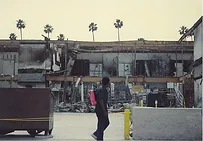About Lesson
Activity 7.3: The Legacy of Saigu

Students examine the legacy of Saigu for Korean Americans. They compare/contrast perspectives in two new articles and consider the future for Korean Americans.
Building burnt to the ground after the riots. (Source: Wikipedia)
Activity Questions
-
- What is the Saigu Legacy?
- In the South Central neighborhoods of Los Angeles, how have race relations changed since Saigu? How have they stayed the same?
- Being caught between two worlds, how do Korean Americans (immigrants) feel the pressures and the divide in the U.S. along racial lines, especially as they enter small businesses and inner-city communities?
- What racial inequalities and mistreatment of Korean Americans during the 1992 LA Civil Unrest/Uprising persist today?
- How does your new understanding of Korean American experiences impact your understanding of Korean American identify?
Instructional Strategies
- Use the Lesson 7: Saigu – The 1992 LA Civil Unrest presentation to support this lesson.
Quick-Writes
-
- Provide students with the following prompt and allow them five minutes to Quick- write their response. Call on student volunteers to share their reflections.
NOTE: Students will use these Quick-writes as their rough drafts for the Summative Assessment.
- A legacy is something that is carried over from a previous generation and handed down from the past to the future. It is believed that building a legacy helps establish stronger communities, but a legacy may also have negative implications.
- Write for 5 minutes about what you feel is the Saigu Legacy. Use these questions to guide your response:
- What is a legacy?
- What is the Saigu Legacy? How does it differ for different individuals or groups?
- Who are all the individuals and groups that contributed to handing down the Saigu legacy?
- Who are all the individuals and groups that were (and continue to be) impacted by the Saigu legacy?
- What would be done in the future to reshape the Legacy of Saigu?
Paired Reading
- Have students access and read the two articles on Saigu’s legacy. (If necessary, distribute copies of articles).
- Pair students and allow them to determine who will read which article. Have them annotate their articles by highlighting examples of the legacy of Saigu.
- Have each student answer the question for their reading and be prepared to share with their partner.
- What might Edward Chang, Carole Park, and Korean American merchants feel is part of the Saigu legacy? Make a list of these elements.
- What might Soon Yoon, Simon Choi, and the Korean American Federation feel is part of the Saigu Legacy? Make a list of these elements.
Return to Quick-writes
- After reading, have each pair of students join another pair (four students total) and share their Quick-writes.
- Have students return to their Quick-writes and add another paragraph that compares and contrasts ideas.
Closing Activity
- Hold class discussion on the Activity Questions, beginning with this one: In the South Central neighborhoods of Los Angeles, how have race relations changed since Saigu? How have they stayed the same?
Resources
- See also Lesson 7 Teacher’s Guide and Lesson 7 Presentation, found under Activity 7.1.
- News Article: 25 Years After LA Riots (Web)
- News Article: 25 Years After LA Riots (PDF)
- News Article: Korean Liquor Store (Web)
- News Article: Korean Liquor Store (PDF)
25 years after LA_riots (PDF)
Korean_liquor_store_LA_Times (PDF)

